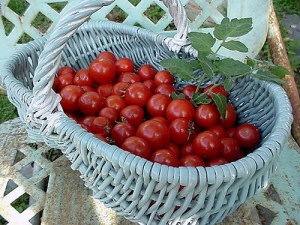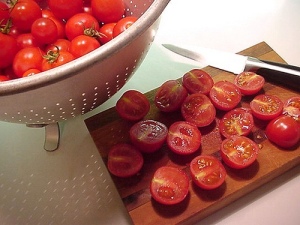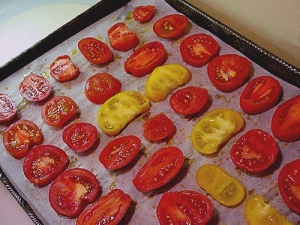How to make your own delicious dried tomatoes
How to dry your tomato harvest to enjoy gourmet dried tomatoes all winter long
If you have a good crop of tomatoes in your garden, more than you can eat or give away, you can preserve them by drying them and enjoy delicious gourmet eating all winter long. Dried tomatoes are tasty additions to fresh pasta, sauces, sandwiches, salads, stir fry dishes and you can also enjoy them just the way they are, as a chewy tangy-sweet snack.
Fresh tomatoes from the garden are almost everyone’s favorite summer produce. Dried tomatoes are even better – their concentrated tomato flavor makes waiting for next season’s fresh crop easier during the long winter months.
You can make dried tomatoes in a commercial dehydrator, but did you know you can dry them in your oven as well as in the sun?
How to Dry Tomatoes in Your Home Oven
- Preheat oven to 200 degrees Fahrenheit.
- Arrange oven racks to allow air flow top and bottom. You can use 4 cooling racks, 2 on each oven rack.
- Slice tomatoes in half lengthwise and arrange skin side down on the cooling racks side by side, not touching. If you’re doing cherry tomatoes, just halve them. If you are doing larger tomatoes, cut them between ¼” and ½” thick. Arrange the slices crosswise to the wires on the cooling racks so they won’t slip through between the wires as they dry and shrink.
- Sprinkle lightly with salt.
- Arrange tomato-filled racks on oven racks, and start timing.
- After 2 hours, start checking tomatoes for dryness. Remove tomatoes as they dry.
- Cool on paper plates or towels, and then transfer to storage containers.
How to tell when the tomatoes are “done”
Drying tomatoes takes time, but you don’t need to stand over the stove or keep close watch for hours. They’ll dry slowly and won’t even need to be checked for dryness for a couple hours after you begin a batch.
After the first two hours, set your oven timer for half-hour intervals and check the tomatoes when the buzzer goes off, removing the finished ones to a foil-lined cookie sheet and then putting them into canning jars when they cool, covering them with extra virgin olive oil. You can add fresh garlic slices, which turn translucent and mellow in the oil, for a nice little added flavor. Store the jars in the fridge.
Tomatoes shrink in size and get slightly darker as they dry, much like the way grapes do when they become raisins; the pulp will feel firm but flexible when they’re done.
Tips:
- Dry tomatoes on a not too hot late summer or early fall day when you are planning to be home all day. It can take up to 12 hours to dry a larger, juicier tomato. Smaller, meatier tomatoes may dry in as few as 9 hours.
- Keep the oven at about 200 degrees and you can do as many as three trays at a time. It takes up to four hours or more at that temperature, depending on whether you are drying cherry tomatoes, Romas, or regular large round tomatoes.
- Every oven is different, and the key is really to watch them like a hawk after an hour or two—especially the tiny cherry tomatoes.
Fresh baby spinach leaves on roasted-garlic artisan baguette, tomato-basil feta, oven-dried home-grown tomatoes in extra virgin olive oil, and fresh sliced garlic cloves.
Whole wheat pasta with oven-dried cherry tomatoes, basil ribbons, and grated Pecorino Romano cheese. Divine!
‘Sun-dried’ Tomato Pasta
After boiling and draining pasta, add chopped sun- or oven-dried tomatoes, crumbled feta cheese (plain or tomato-basil), pitted and halved kalamata olives, several large fresh garlic cloves, chopped, extra virgin olive oil and fresh basil “ribbons” cut with scissors across the width of the leaves, salt and pepper to taste. The red, green, black and white ingredients look lovely together and it’s delicious.
Our own Bass Lake Farmer’s Market is still growing on until late in September. They have vegetables and fruit, flowers, nuts, honey, music and more. They have tomatoes!
Recent Posts
How to Be a Lazy Gardener
...and still have a pretty garden With a busy household and jobs, we are…
Summer is Spring at Whiskey Falls!
Take a day trip to Whiskey Falls... Come visit Whiskey Falls and the surrounding high…
California oak acorns: Feast or famine
Why do oaks drop more acorns some years and not others? If you have live…
Mule’s ear and Farewell to Spring
Roadside treasures worth stopping for In the first week of July in the Sierra foothills…
Our favorite butterfly plants
Wow! Butterflies love these plants! Grow any of these for instant results and each is…
A water-saving veggie garden for the foothills
Your water-wise veggie garden Does everyone in our Mountain Community grow at least one tomato?…




